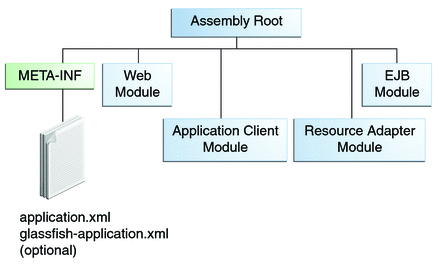Packaging Applications - The Java EE 6 Tutorial (original) (raw)
Distributed Multitiered Applications
The JavaBeans Component Architecture
Enterprise Information System Tier
Java EE Application Assembly and Deployment
Application Component Provider
Application Deployer and Administrator
Enterprise JavaBeans Technology
JavaServer Pages Standard Tag Library
Java API for RESTful Web Services
Contexts and Dependency Injection for the Java EE Platform (JSR 299)
Dependency Injection for Java (JSR 330)
Java EE Connector Architecture
Java Authorization Contract for Containers
Java Authentication Service Provider Interface for Containers
Java EE 6 APIs in the Java Platform, Standard Edition 6 and 7
Java Database Connectivity API
Java Naming and Directory Interface API
JavaBeans Activation Framework
Java Architecture for XML Binding
SOAP with Attachments API for Java
Java Authentication and Authorization Service
2. Using the Tutorial Examples
3. Getting Started with Web Applications
4. JavaServer Faces Technology
7. Using JavaServer Faces Technology in Web Pages
8. Using Converters, Listeners, and Validators
9. Developing with JavaServer Faces Technology
10. JavaServer Faces Technology: Advanced Concepts
11. Using Ajax with JavaServer Faces Technology
12. Composite Components: Advanced Topics and Example
13. Creating Custom UI Components and Other Custom Objects
14. Configuring JavaServer Faces Applications
16. Uploading Files with Java Servlet Technology
17. Internationalizing and Localizing Web Applications
18. Introduction to Web Services
19. Building Web Services with JAX-WS
20. Building RESTful Web Services with JAX-RS
21. JAX-RS: Advanced Topics and Example
23. Getting Started with Enterprise Beans
24. Running the Enterprise Bean Examples
25. A Message-Driven Bean Example
26. Using the Embedded Enterprise Bean Container
27. Using Asynchronous Method Invocation in Session Beans
Part V Contexts and Dependency Injection for the Java EE Platform
28. Introduction to Contexts and Dependency Injection for the Java EE Platform
29. Running the Basic Contexts and Dependency Injection Examples
30. Contexts and Dependency Injection for the Java EE Platform: Advanced Topics
31. Running the Advanced Contexts and Dependency Injection Examples
32. Introduction to the Java Persistence API
33. Running the Persistence Examples
34. The Java Persistence Query Language
35. Using the Criteria API to Create Queries
36. Creating and Using String-Based Criteria Queries
37. Controlling Concurrent Access to Entity Data with Locking
38. Using a Second-Level Cache with Java Persistence API Applications
39. Introduction to Security in the Java EE Platform
40. Getting Started Securing Web Applications
41. Getting Started Securing Enterprise Applications
42. Java EE Security: Advanced Topics
Part VIII Java EE Supporting Technologies
43. Introduction to Java EE Supporting Technologies
45. Resources and Resource Adapters
46. The Resource Adapter Example
47. Java Message Service Concepts
48. Java Message Service Examples
49. Bean Validation: Advanced Topics
50. Using Java EE Interceptors
51. Duke's Bookstore Case Study Example
52. Duke's Tutoring Case Study Example
53. Duke's Forest Case Study Example
A Java EE application is delivered in a Java Archive (JAR) file, a Web Archive (WAR) file, or an Enterprise Archive (EAR) file. A WAR or EAR file is a standard JAR (.jar) file with a .war or .earextension. Using JAR, WAR, and EAR files and modules makes it possible to assemble a number of different Java EE applications using some of the same components. No extra coding is needed; it is only a matter of assembling (or packaging) various Java EE modules into Java EE JAR, WAR, or EAR files.
An EAR file (see Figure 1-6) contains Java EE modules and, optionally, deployment descriptors. A deployment descriptor, an XML document with an .xml extension, describes the deployment settings of an application, a module, or a component. Because deployment descriptor information is declarative, it can be changed without the need to modify the source code. At runtime, the Java EE server reads the deployment descriptor and acts upon the application, module, or component accordingly.
Figure 1-6 EAR File Structure

The two types of deployment descriptors are Java EE and runtime. A Java EE deployment descriptoris defined by a Java EE specification and can be used to configure deployment settings on any Java EE-compliant implementation. A runtime deployment descriptor is used to configure Java EE implementation-specific parameters. For example, the GlassFish Server runtime deployment descriptor contains such information as the context root of a web application, as well as GlassFish Server implementation-specific parameters, such as caching directives. The GlassFish Server runtime deployment descriptors are named glassfish-moduleType.xml and are located in the same META-INF directory as the Java EE deployment descriptor.
A Java EE module consists of one or more Java EE components for the same container type and, optionally, one component deployment descriptor of that type. An enterprise bean module deployment descriptor, for example, declares transaction attributes and security authorizations for an enterprise bean. A Java EE module can be deployed as a stand-alone module.
Java EE modules are of the following types:
- EJB modules, which contain class files for enterprise beans and, optionally, an EJB deployment descriptor. EJB modules are packaged as JAR files with a .jar extension.
- Web modules, which contain servlet class files, web files, supporting class files, image and HTML files, and, optionally, a web application deployment descriptor. Web modules are packaged as JAR files with a .war (web archive) extension.
- Application client modules, which contain class files and, optionally, an application client deployment descriptor. Application client modules are packaged as JAR files with a .jar extension.
- Resource adapter modules, which contain all Java interfaces, classes, native libraries, and, optionally, a resource adapter deployment descriptor. Together, these implement the Connector architecture (see Java EE Connector Architecture) for a particular EIS. Resource adapter modules are packaged as JAR files with an .rar (resource adapter archive) extension.
Copyright © 2013, Oracle and/or its affiliates. All rights reserved. Legal Notices


